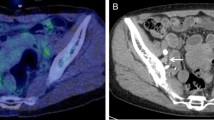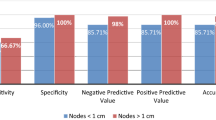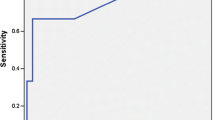Abstract
Purpose
The purpose of this study was to prospectively determine the diagnostic accuracy of PET/CT in the detection of recurrence in patients with treated uterine cancers.
Methods
Twenty-five women, ranging in age from 37 to 79 years (mean 58.9 years), who underwent primary surgical treatment for either a cervical or an endometrial cancer met the inclusion criterion of the study, which was suspicion of recurrence based on results of routine follow-up procedures. PET/CT was performed after administration of 18F-fluorodeoxyglucose (FDG); two readers interpreted the images in consensus. Histopathological findings or correlation with results of subsequent clinical and imaging follow-up examinations served as the reference standard. Diagnostic accuracy of PET/CT was reported in terms of the proportion of correctly classified patients and lesion sites.
Results
Tumour recurrence was found at histopathological analysis or follow-up examinations after PET/CT in 14 (56%) of the 25 patients. Patient-based sensitivity, specificity, positive predictive value, negative predictive value and accuracy of PET/CT for detection of tumour recurrence were 92.9%, 100.0%, 100.0%, 91.7% and 96.0%, respectively. Lesion site-based sensitivity, specificity, positive predictive value, negative predictive value and accuracy of PET/CT were 94.7%, 99.5%, 94.7%, 99.5% and 99.0%, respectively.
Conclusion
This preliminary study shows that PET/CT may be an accurate method for the evaluation of recurrence in patients who have been treated for uterine cancers and are undergoing follow-up.


Similar content being viewed by others
References
Rose PG. Endometrial carcinoma. N Engl J Med 1996;335:640–9.
Waggoner SE. Cervical cancer. Lancet 2003;361:2217–25.
Benedet JL, Bender H, Jones H, Ngan HY, Pecorelli S. FIGO staging classifications and clinical practice guidelines in the management of gynecologic cancers. FIGO Committee on Gynecologic Oncology. Int J Gynecol Obstet 2000;70:209–62.
Disaia PJ, Creasman WT. Clinical gynecologic oncology. 6th ed. St. Louis: Mosby; 2001; p 89–93.
Eifel PJ, Berek JS, Thigpen JT. Cancer of the cervix, vagina and vulva. In: de Vita VTJ, Hellman S, Rosenberg SA, editors. Cancer. Principles and practice of oncology. 5th ed., Philadelphia: Lippincott-Raven; 1997; p 1433–78.
Barakat RR, Greven K, Markman M, Thigpen JT. Cancer management. A multi-disciplinary approach. In: Endometrial cancer. 5th ed. New York: PRR Inc; 2001.
Salvesen HB, Akslen LA, Iversen T, Iversen OE. Recurrence of endometrial carcinoma and the value of routine follow-up. Br J Obstet Gynaecol 1997;104:1302–7.
Bodurka-Bevers D, Morris M, Eifel PJ, Levenback C, Bevers MW, Lucas KR, et al. Posttherapy surveillance of women with cervical cancer: an outcomes analysis. Gynecol Oncol 2000;78:187–93.
Olaitan A, Murdoch J, Anderson R, James J, Graham J, Barley V. A critical evaluation of current protocols for the follow-up of women treated for gynecological malignancies: a pilot study. Int J Gynecol Cancer 2001;11:349–53.
Maiman M. The clinical application of serum squamous cell carcinoma antigen level monitoring in invasive cervical carcinoma. Gynecol Oncol 2002;84:4–6.
Kurihara T, Mizunuma H, Obara M, Andoh K, Ibuki Y, Nishimura T. Determination of a normal level of serum CA 125 in postmenopausal women as a tool for preoperative evaluation and postoperative surveillance of endometrial carcinoma. Gynecol Oncol 1998;69:192–6.
Ebner F, Kressel HY, Mintz MC, Carlson JA, Cohen EK, Schiebler M, et al. Tumor recurrence versus fibrosis in the female pelvis: differentiation with MR imaging at 1.5 T. Radiology 1988;166:333–40.
Weber TM, Sostman HD, Spritzer CE, Ballard RL. Cervical carcinoma: determination of recurrent tumor extent versus radiation changes with MR imaging.Radiology 1995;194:135–9.
Hawighorst H, Knapstein PG, Schaeffer U, Knopp MV, Brix G, Hoffmann U, et al. Pelvic lesions in patients with cervical carcinoma: efficacy of pharmacokinetic analysis of dynamic MR images in distinguishing recurrent tumors from benign conditions. AJR 1996;166:401–8.
Yamashita Y, Harada M, Torashima M, Takahashi M, Miyazaki K, Tanaka N, et al. Dynamic MR imaging of recurrent postoperative cervical cancer. J Magn Reson Imaging 1996;1:167–71.
Kinkel K, Ariche M, Tardivon AA, Spatz A, Castaigne D, Lhomme C, et al. Differentiation between recurrent tumor and benign conditions after treatment of gynaecologic pelvic carcinoma: value of dynamic contrast-enhanced subtraction MR imaging. Radiology 1997;204:55–63.
Yang WT, Lam WW, Yu MY, Cheung TH, Metreweli C. Comparison of dynamic helical CT and dynamic MR imaging in the evaluation of pelvic lymph nodes in cervical carcinoma. AJR 2000;175:759–68.
Connor JP, Andrews JI, Anderson B, Buller RE. Computed tomography in endometrial carcinoma. Obstet Gynecol 2000;95:692–6.
Rohren EM, Turkington TG, Coleman RE. Clinical applications of PET in oncology. Radiology 2004;231:305–32.
Anzai Y, Carroll WR, Quint DJ, Bradford CR, Minoshima S, Wolf GT, et al. Recurrence of head and neck cancer after surgery or irradiation: prospective comparison of FDG PET and MR imaging diagnoses. Radiology 1996;200:135–41.
Schelling M, Avril N, Nahrig J, Kuhn W, Romer W, Sattler D, et al. Positron emission tomography using FDG for monitoring primary chemotheapy in breast cancer. J Clin Oncol 2000;18:1689–95.
Kalff V, Hicks RJ, Ware RE, Hogg A, Binns D, McKenzie AF. The clinical impact of 18F-FDG PET in patients with suspected or confirmed recurrence of colorectal cancer: a prospective study. J Nucl Med 2002;43:492–9.
Nakamoto Y, Saga T, Ishimori T, Mamede M, Togashi K, Higuchi T, et al. Clinical value of positron emission tomography with FDG for recurrent ovarian cancer. AJR Am J Roentgenol 2001;176:1449–54.
Sugawara Y, Eisbruch A, Kosuda S, Recker BE, Kison PV, Wahl R. Evaluation of FDG PET in patients with cervical cancer. J Nucl Med 1999;40:1125–31.
Sun SS, Chen TC, Yen RF, Shen YY, Changlai SP, Kao A. Value of whole body FDG PET in the evaluation of recurrent cervical cancer. Anticancer Res 2001;21:2957–62.
Belhocine T, De Barsy C, Hustinx R, Willems-Foidart J. Usefulness of FDG PET in the posttherapy surveillance of endometrial carcinoma. Eur J Nucl Med Mol Imaging 2002;29:1132–9.
Ryu SY, Kim MH, Choi SC, Choi CW, Lee KH. Detection of early recurrence with FDG PET in patients with cervical cancer. J Nucl Med 2003;44:347–52.
Grigsby PW, Siegel BA, Dehdashti F, Rader J, Zoberi I. Posttherapy FDG PET in carcinoma of the cervix: response and outcome. J Clin Oncol 2004;22:2167–71.
Grigsby PW, Siegel BA, Dehdashti F, Mutch DG. Post-therapy surveillance monitoring of cervical cancer by FDG PET. Int J Radiat Oncol Biol Phys 2003;55:907–13.
Townsend DW. A combined PET/CT scanner. J Nucl Med 2001;42:533–4.
Bar-Shalom R, Yefremov N, Guralnik L, Gaitini D, Frenkel A, Kuten A, et al. Clinical performance of PET/CT in evaluation of cancer: additional value for diagnostic imaging and patient management. J Nucl Med 2003;44:1200–9.
Gutzeit A, Antoch G, Kuhl H, Egelhof T, Fischer M, Hauth E, et al. Unknown primary tumors: detection with dual-modality PET/CT. Initial experience. Radiology 2005;234:227–34.
Even-Sapir E, Parag Y, Lerman H, Gutman M, Levine C, Rabau M, et al. Detection of recurrence in patients with rectal cancer: PET/CT after abdominoperineal or anterior resection. Radiology 2004;232:815–22.
Sironi S, Messa C, Mangili G, Zangheri B, Aletti G, Garavaglia E, et al. Integrated FDG PET/CT in patients with persistent ovarian cancer: correlation with histopathologic findings. Radiology 2004;233:433–40.
Ahn C. Statistical methods for the estimation of sensitivity and specificity of site-specific diagnostic test. J Periodontal Res 1997;32:351–4.
Brown LD, Cai TT, Das Gupta A. Interval estimation for a binomial proportion. Stat Sci 2001;16:101–33.
Saga T, Higashi T, Ishimori T, Mamede M, Nakamoto Y, Mukai T, et al. Clinical value of FDG-PET in the follow-up of postoperative patients with endometrial cancer. Ann Nucl Med 2003;17:197–203.
Chao A, Chang TC, Ng KK, Hsueh S, Huang HJ, Chou HH, et al. FDG PET in the management of endometrial cancer. Eur J Nucl Med Mol Imaging 2006;33:36–44.
Grisaru D, Almog B, Levine C, Metser U, Fishman A, Lerman H, et al. The diagnostic accuracy of FDG PET/CT in patients with gynecological malignancies. Gynecol Oncol 2004;94:680–4.
Belhocine T. 18F-FDG PET imaging in posttherapy monitoring of cervical cancers: from diagnosis to prognosis. J Nucl Med 2004;45:1602–4.
Bristow RE, Del Carmen MG, Pannu HK, Cohade C, Zahurak ML, Fishman EK, et al. Clinically occult recurrent ovarian cancer: patient selection for secondary cytoreductive surgery using combined PET/CT. Gynecol Oncol 2003;90:519–28.
Cohade C, Osman M, Nakamoto Y, Marshall LT, Links JM, Fishman EK, et al. Initial experience with oral contrast in PET/ CT: phantom and clinical studies. J Nucl Med 2003;44:412–6.
Nakamoto Y, Chin BB, Kraitchman DL, Lawler LP, Marshall LT, Wahl RL. Effects of nonionic intravenous contrast agents at PET/CT imaging: phantom and canine studies. Radiology 2003;227:817–24.
Coleman RE, Delbeke D, Guiberteau MJ, Conti PS, Royal HD, Weinreb JC, et al. Concurrent PET/CT with an integrated imaging system: intersociety dialogue from the joint working group of the American College of Radiology, the Society of Nuclear Medicine, and the Society of Computed Body Tomography and Magnetic Resonance. J Nucl Med 2005;46:1225–39.
von Schulthess GK, Steinert HC, Hany TF. Integrated PET/CT: current applications and future directions. Radiology 2006;238:405–22.
Author information
Authors and Affiliations
Corresponding author
Rights and permissions
About this article
Cite this article
Sironi, S., Picchio, M., Landoni, C. et al. Post-therapy surveillance of patients with uterine cancers: value of integrated FDG PET/CT in the detection of recurrence. Eur J Nucl Med Mol Imaging 34, 472–479 (2007). https://doi.org/10.1007/s00259-006-0251-y
Received:
Accepted:
Published:
Issue Date:
DOI: https://doi.org/10.1007/s00259-006-0251-y




